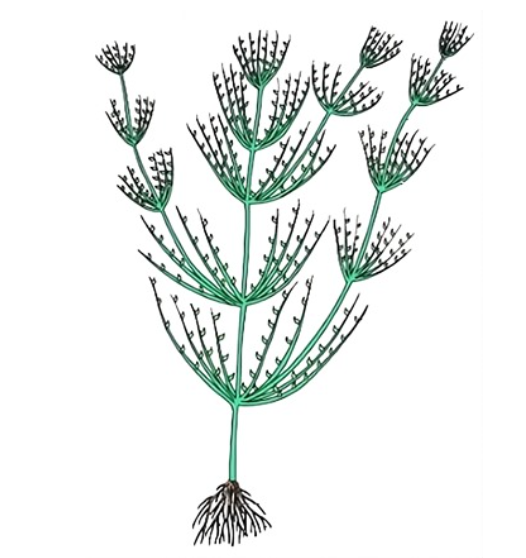Select Question Set:
Given below are two statements:
Statement I: Bryophytes are also called amphibians of plant kingdom because they can live in soil are not dependent on water for sexual reproduction
Statement II: The main plant body of bryophytes is diploid and is called sporophyte
In the light of the above statements, choose the most appropriate answer from the options given below
1. Both Statement I and Statement II are true
2. Both Statement and Statement II are false
3. Statement I is true but statement II is false
4. Statement I is false but statement II is true
Subtopic: Bryophytes |
78%
Level 2: 60%+
Please attempt this question first.
Hints
Please attempt this question first.
Match List-I with List-II:
Choose the correct answer from the options given below:
| List-I | List-II | ||
| (a) | Chlamydomonas | (i) | Moss |
| (b) | Cycas | (ii) | Pteridophyte |
| (c) | Selaginella | (iii) | Alga |
| (d) | Sphagnum | (iv) | Gymnosperm |
| (a) | (b) | (c) | (d) | |
| 1. | (iii) | (i) | (ii) | (iv) |
| 2. | (iii) | (iv) | (ii) | (i) |
| 3. | (iii) | (ii) | (i) | (iv) |
| 4. | (ii) | (iii) | (i) | (iv) |
Subtopic: Algae | Bryophytes | Pteridophytes | Gymnosperms |
91%
Level 1: 80%+
NEET - 2022
Hints
Read the following statements and identify the characters related to the alga shown in the diagram:

| a. | It is a member of Chlorophyceae. |
| b. | Food is stored in the form of starch. |
| c. | It is a monoecious plant showing oogonium and antheridium. |
| d. | Food is stored in the form of laminarin or mannitol. |
| e. | It shows dominance of pigments chlorophyll a, c and Fucoxanthin. |
| 1. | (a) and (b) only | 2. | (a), (b) and (c) only |
| 3. | (a), (c) and (d) only | 4. | (c), (d) and (e) only |
Subtopic: Chlorophyceae: Green Algae: I |
51%
Level 3: 35%-60%
NEET - 2022
Hints
Select the incorrect statement with respect to algae.
| 1. | The food stored in red algae is in the form of floridean starch |
| 2. | Pyrenoids in green algae contain protein besides starch |
| 3. | Asexual reproduction in most brown algae is by non-motile spores |
| 4. | Brown algae show great variation in size and form |
Subtopic: Algae |
82%
Level 1: 80%+
Please attempt this question first.
Hints
Please attempt this question first.
In gymnosperms:
| 1. | The female gametophyte has independent free-living existence. |
| 2. | Two different types of spores are produced. |
| 3. | Ovules are enclosed by an ovary wall. |
| 4. | Pollen grains are carried to the ovule by water currents. |
Subtopic: Gymnosperms |
77%
Level 2: 60%+
Please attempt this question first.
Hints
Please attempt this question first.
The given figure represents the life cycle of:
.svg-cropped.svg)
.svg-cropped.svg)
| 1. | a homosporous plant with bisexual gametophytes |
| 2. | a heterosporous plant with bisexual gametophytes |
| 3. | a homosporous plant with unisexual gametophytes |
| 4. | a heterosporous plant with unisexual gametophytes |
Subtopic: Pteridophytes |
51%
Level 3: 35%-60%
Hints
The given figure represents the life cycle of a typical:


| 1. Gymnosperm | 2. Angiosperm |
| 3. Bryophyte | 4. Pteridophyte |
91%
Level 1: 80%+
Hints
The given figure represents:
| 1. | Equisetum, a horsetail where A is macrophyll and B is microphyll |
| 2. | Sphagnum, peat moss where A is microphyll and B is macrophyll |
| 3. | Equisetum, a horsetail where A is archegonial branch and B is antheridial branch |
| 4. | Sphagnum, peat moss where A is archegonial branch and B is antheridial branch |
Subtopic: Bryophytes |
71%
Level 2: 60%+
Hints
The given structure belongs to:


| 1. | the gametophytic generation in the life cycle of a fern |
| 2. | the sporophytic generation in the life cycle of a fern |
| 3. | the gametophytic generation in the life cycle of a moss |
| 4. | the sporophytic generation in the life cycle of a moss |
Subtopic: Bryophytes |
Level 3: 35%-60%
Hints
The given diagram shows:

1. The male thallus of Marchantia
2. The female thallus of Marchantia
3. The male thallus of Funaria
4.The female thallus of Funaria

1. The male thallus of Marchantia
2. The female thallus of Marchantia
3. The male thallus of Funaria
4.The female thallus of Funaria
Subtopic: Bryophytes |
84%
Level 1: 80%+
Please attempt this question first.
Hints
Select Question Set:







